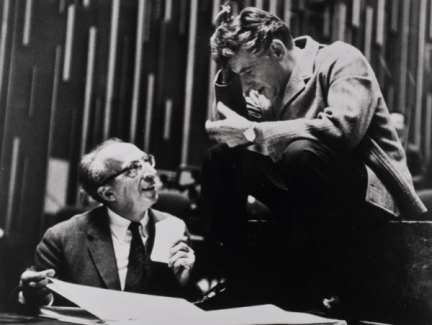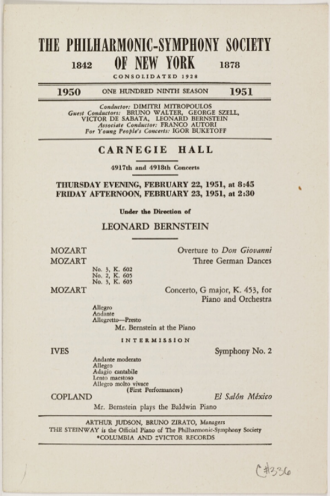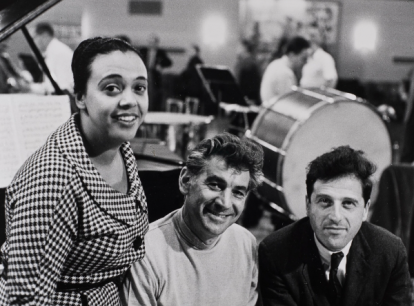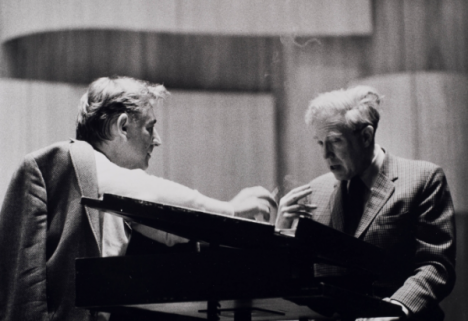Latest News
Leonard Bernstein: A Legacy of Premieres
Posted May 29, 2024
Leonard Bernstein: A Legacy of Premieres
By Craig Urquhart

Aaron Copland and Leonard Bernstein at the rehearsal for the world premiere of Copland’s Connotations, performed by the NYP at the opening of Philharmonic Hall in 1962. Courtesy of the New York Philharmonic Archives.
When one thinks of the conducting legacy of Leonard Bernstein, his dedication to the works of Mahler, Beethoven, Brahms, Schumann, and other titans of musical history immediately comes to mind. However, this leaves out his equally important contributions as a conductor and champion of the music of his time.
Over his lifetime, Bernstein premiered over 50 works for orchestra, mostly with the New York Philharmonic. But even before his tenure with the New York Philharmonic, Bernstein was premiering significant works -- such as the opera Peter Grimes by Benjamin Britten for its US premiere at the Tanglewood Music Festival in 1946. In 1949, he premiered Olivier Messiaen’s monumental Turangalîla-Symphonie with the Boston Symphony. In 1951, he gave the long-delayed world premiere of Charles Ives's Symphony No. 2, centrally placing this iconic composition in the canon of American symphonic music. Also during those pre-Philharmonic years, Bernstein first performances of his own works: Symphony No. 2: The Age of Anxiety in 1949, with his mentor Serge Koussevitzky conducting the Boston Symphony with Bernstein at the piano; and in 1954 he premiered his Serenade with the Orchestra Del Teatro La Fenice and Isaac Stern as the violin soloist.

With his appointment as Music Director of the New York Philharmonic in 1958, Bernstein’s commitment to presenting contemporary music received a firm platform. As Music Director, Bernstein was particularly dedicated to premiering works by American composers. These compositions included Aaron Copland’s Connotations and Inscape; Ned Rorem’s Symphony No. 3; and premieres of works by Lukas Foss, including Foss’s Time Cycle, as well as David Diamond’s Symphony No. 5 and William Schuman’s Symphony No. 8.

Adele Addison, Leonard Bernstein, Lukas Foss rehearse Foss’s Time Cycle, Oct. 1960. Courtesy of the New York Philharmonic Archives.
The list of works by American composers comprises a portrait of the era's musical diversity, and includes works by Grant Beglarian, Elliott Carter, John Corigliano, Henry Cowell, David Del Tredici, Daniel Pinkham, Walter Piston, and Gunther Schuller -- as well as the avant-garde Concerted Piece for Tape Recorder and Orchestra by Otto Luening and Vladimir Ussachevsky.

Leonard Bernstein and Elliott Carter, January 1969. Courtesy of New York Philharmonic Archives.
Bernstein also gave world premieres of pieces by international composers. This list includes Hans Werner Henze’s Symphony No. 5; Alberto Ginastera’s Violin Concerto; and Carlos Chavez’s Symphony No. 6. Bernstein also introduced works by Shostakovich, Xenakis, Ligeti, and Boulez.

Leonard Bernstein and Alberto Ginastera, May 28, 1958, courtesy of the New York Philharmonic Archvies.
As a composer, Bernstein introduced his own Chichester Psalms; Suite No. 1 from Dybbuk; and selections from Songfest with the New York Philharmonic.
Bernstein’s strong commitment to the music of his time is an often-overlooked part of his legacy as a conductor. That legacy continues to make its presence felt in today’s world. Orchestras around the globe are more devoted than ever to presenting compositions by living composers – even if that music may sometimes challenge the public. After all, as Bernstein so keenly understood without new works, an orchestra restricts itself to being a museum rather than an incubator of living art, and an active participant in the future of symphonic music.
For a complete list of premieres and commissions of the New York Philharmonic, please visit: New York Philharmonic History.